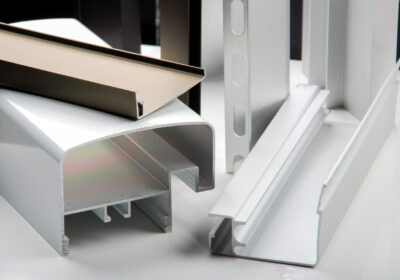Aluminum extrusion design allows for sleek profiles, light strong sections, and an almost endless array of custom shapes. But to fully exploit the advantages of aluminum extrusion, more than creativity is required: one needs Design for Manufacturability.
DfM is simultaneously the art and science of designing products so that they can be efficiently manufactured without sacrificing functionality, performance, or aesthetics. In the design of aluminum extrusions, this involves knowledge in how design geometry, material behavior, and process limitations interact within the extrusion process.
At Can Art Aluminum Extrusion Canada Inc., we work with designers and engineers to close the gap between imagination and manufacturability, helping you optimize every design for performance, precision, and cost efficiency.
Following are five of the key DfM principles that every engineer and product designer should follow when working with aluminum extrusions.
Simplify Profile Geometry: The Power of Design Simplicity
While complex shapes may look impressive in CAD, simplicity is strength where extrusion is concerned. Each bend, tongue, hollow, and undercut adds another layer of complication to the die that can compromise the quality of the extrusion, raise the cost, and restrict the tolerances.
Key Aluminum Extrusion Design Tips
- Geometry should be uniform and balanced. Symmetrical profiles extrude more evenly.
- Avoid any deep hollows and voids that are not functionally necessary.
- Control tongue ratio: the lower this ratio, less than 3:1, the better the die stability and hence less possibility of breakage.
- Avoid sharp corners; instead, use at least 0.5–1 mm radii for smoother metal flow.
- Where possible, combining several parts into one extrusion will make later assembly much easier.
Maintain Uniform Wall Thickness
One of the golden rules when it comes to designing aluminum extrusions is to have uniform wall thickness. Variable wall thickness results in variable metal flow in the process of extrusion, which can result in warping, surface defects, or dimensional inaccuracies.
Best Practices for Wall Thickness
- Keep the wall thickness of the profile consistent for uniform cooling, which ensures dimensional stability.
- Where variable thickness cannot be avoided, the transition should be gradual without any abruptness.
- Minimum wall thickness of the aluminum extrusions usually ranges from 1.0 to 1.5 mm, depending upon the alloy, design, and application.
- Thicker walls will lead to weight increases and thus cost, so balance strength with material economy.
Question Answered:
What is the minimum wall thickness for aluminum extrusion?
Most structural or architectural profiles can have a section thickness in the range of 1.0–1.5 mm, though high-strength applications may require thicker sections.
Design for Cost Efficiency and Post-Extrusion Processes
Every design decision affects manufacturing cost—not just in extrusion, but in machining, finishing, and assembly. DfM encourages you to consider the total lifecycle cost right up front.
Cost Reduction Strategies
- Minimize machining by incorporating design features in the profile, including grooves or channels.
- Avoid excessive hollows requiring complicated multi-part dies.
- Use standard extrusion dies wherever possible, or modify existing ones where feasible.
- Design for post-extrusion finishing: the surfaces should be designed to enable easy anodizing, powder coating, or polishing.
- For assembly integration, the application of screw bosses, snap fits, and interlocking joints will reduce the need for hardware or welding.
Account for Aluminum Extrusion Tolerances and Dimensional Accuracy
Every process of extrusion has certain natural limitations to dimensional precision. Understanding the tolerances of aluminum extrusion will help ensure your design performs as it should and remains manufacturable.
Tolerancing Guidelines
- Base tolerances according to AA (Aluminum Association) or EN 755-9.
- Tight tolerances increase the cost of production. Use them only in functional areas.
- Allow for thermal expansion and contraction, especially for long profiles.
- Machining or secondary operations on critical assembly parts should be done after extrusion to achieve tight fits.
Common Extrusion Design Considerations
- Profile complexity: More complex shapes have wider tolerances.
- Die wear and temperature: Affect long-term dimensional consistency.
- Extrusion direction: For better accuracy, key dimensions should be aligned with the flow direction.
Discussion Question Answered:
How do you design for aluminum extrusion?
With uniform walls, simple geometry, real-world tolerances, and early collaboration with your extruder, every design feature can be produced and finished consistently.
Optimize for Assembly, Strength, and Material Performance
A well-designed extrusion doesn’t just look good; it fits, functions, and lasts. DfM extends into the areas of assembly and structural performance, where design choices can affect product integrity and usability.
Assembly and Structural Design Principles
- Include features of fastening to make joining easy, like screw bosses or snap fits.
- Consider material selection carefully: The 6000 series, including the 6061 and 6063 aluminum alloys, present good strength, machinability, and surface finish.
- Provide validation of structural integrity and load paths using finite element analysis.
- Design profiles that avoid stress concentrations, especially by rounding the internal corners.
- Consider the dimensional accuracy of mating parts to ensure proper fitting during assembly.
Question Answered:
What are the key principles of DfM?
Simplify design: Maintain consistency in walls, design for cost and tolerances in mind, and think about strength and assembly early on.
The Can Art Perspective: Designing Smarter, Manufacturing Better
Great design starts with great collaboration, and that is a belief at Can Art Aluminum Extrusion Canada Inc.. We combine engineering insights, material science, and real-world extrusion experience in our DfM process to ensure every profile performs beautifully, from concept to production.
We Assist Clients With
- Material and alloy selection
- CAD design reviews and simulation
- Die design and prototyping
- Post-extrusion finishing and assembly optimisation
Be it a complicated architectural framework, a precision machine component, or an EV structure, our engineering team will ensure that your aluminum profile meets the highest standards of quality, accuracy, and efficiency.
Smarter Design, Better Manufacturing
Design for Manufacturability (DfM) is much more than making things easier to make; it should be about making them better, smarter, and more economical.
By following these five fundamentals, you will be able to create lightweight, durable, and cost-efficient aluminum extrusions ready for scalable production.
At Can Art Aluminum Extrusion Canada Inc., we turn smart design into flawless execution so you can make the most of every millimeter of aluminum.





